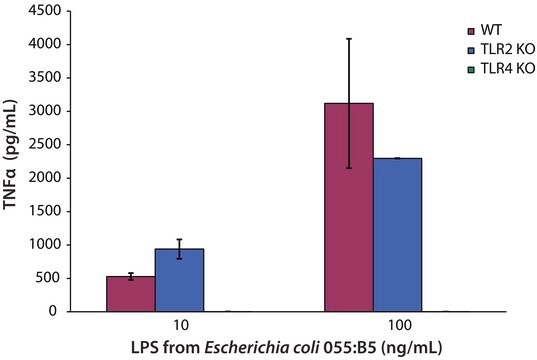L9023
Lipopolysaccharides from Escherichia coli O55:B5
Detoxified
Synonyme(s) :
LPS
Se connecterpour consulter vos tarifs contractuels et ceux de votre entreprise/organisme
About This Item
Produits recommandés
Source biologique
Escherichia coli (O55:B5)
Niveau de qualité
Forme
lyophilized powder
Conditions d'expédition
ambient
Température de stockage
2-8°C
Vous recherchez des produits similaires ? Visite Guide de comparaison des produits
Description générale
This product is extracted from E. coli serotype O55:B5 and purified by chromatography. The source strain is CDC 1644-70. The lipid A moiety has been partially delipidated by alkaline hydrolysis. Removal of the fatty acid portions of lipid A results in a detoxified LPS with an endotoxin level about 10,000 times lower than that of the parent LPS.
Application
Les lipopolysaccharides (LPS) sont des constituants caractéristiques de la paroi cellulaire des bactéries à Gram négatif. Les LPS et leur fraction lipidique (lipide A) stimulent les cellules du système immunitaire inné via le récepteur TLR4 (Toll-Like Receptor 4), un membre de la famille des récepteurs de type Toll, qui reconnaît la signature moléculaire des principaux agents pathogènes (PAMP).
Actions biochimiques/physiologiques
Lipopolysaccharides (LPS) are localized in the outer layer of the membrane and are, in noncapsulated strains, exposed on the cell surface. They contribute to the integrity of the outer membrane, and protect the cell against the action of bile salts and lipophilic antibiotics.
Notes préparatoires
Chromatographically purified; delipidized by alkaline hydrolysis
The product is soluble in water (5 mg/ml) or cell culture medium (1 mg/ml) yielding a hazy, faint yellow solution. A more concentrated, though still hazy, solution (20 mg/ml) has been achieved in aqueous saline after vortexing and warming to 70-80 oC. Lipopolysaccharides are molecules that form micelles in every solvent. Hazy solutions are observed in water and phosphate buffered saline. Organic solvents do not give clearer solutions. Methanol yields a turbid suspension with floaters, while water yields a homogeneously hazy solution.
The product is soluble in water (5 mg/ml) or cell culture medium (1 mg/ml) yielding a hazy, faint yellow solution. A more concentrated, though still hazy, solution (20 mg/ml) has been achieved in aqueous saline after vortexing and warming to 70-80 oC. Lipopolysaccharides are molecules that form micelles in every solvent. Hazy solutions are observed in water and phosphate buffered saline. Organic solvents do not give clearer solutions. Methanol yields a turbid suspension with floaters, while water yields a homogeneously hazy solution.
Mention d'avertissement
Danger
Mentions de danger
Conseils de prudence
Classification des risques
Acute Tox. 2 Oral
Code de la classe de stockage
6.1A - Combustible, acute toxic Cat. 1 and 2 / very toxic hazardous materials
Classe de danger pour l'eau (WGK)
WGK 3
Point d'éclair (°F)
Not applicable
Point d'éclair (°C)
Not applicable
Équipement de protection individuelle
Eyeshields, Gloves, type N95 (US)
Faites votre choix parmi les versions les plus récentes :
Déjà en possession de ce produit ?
Retrouvez la documentation relative aux produits que vous avez récemment achetés dans la Bibliothèque de documents.
Les clients ont également consulté
Ding, H.F., et al.
Journal of Medical Microbiology, 31, 93-93 (1990)
Chong Liu et al.
World journal of gastroenterology, 15(46), 5843-5850 (2009-12-10)
To investigate the dysfunction of the immunological barrier of the intestinal mucosa during endotoxemia and to elucidate the potential mechanism of this dysfunction. Male Wistar rats were randomly distributed into two groups: control group and lipopolysaccharide (LPS) group. Endotoxemia was
Evangelos J Giamarellos-Bourboulis et al.
PloS one, 4(12), e8393-e8393 (2009-12-29)
The pandemic by the novel H1N1 virus has created the need to study any probable effects of that infection in the immune system of the host. Blood was sampled within the first two days of the presentation of signs of
James A Listman et al.
Molecular immunology, 45(9), 2667-2677 (2008-03-01)
The immediate early (IE) proteins of human cytomegalovirus (hCMV) have diverse roles in directing viral and host cell transcription. Among these is the ability of IE2 to induce transcription of the IL1B gene that codes for IL-1beta in monocytes. This
Sophie Van Linthout et al.
Journal of molecular medicine (Berlin, Germany), 89(2), 151-160 (2010-10-26)
The protective effects of high-density lipoprotein (HDL) under lipopolysaccharide (LPS) conditions have been well documented. Here, we investigated whether an effect of HDL on Toll-like receptor 4 (TLR4) expression and signalling may contribute to its endothelial-protective effects and to improved
Notre équipe de scientifiques dispose d'une expérience dans tous les secteurs de la recherche, notamment en sciences de la vie, science des matériaux, synthèse chimique, chromatographie, analyse et dans de nombreux autres domaines..
Contacter notre Service technique



